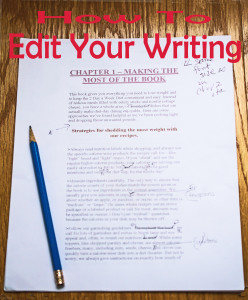Nancy Baggett, 7 Steps to Tastier Food Writing © 2011
Seven Steps to Tastier Food Writing
1. Dive right into your story.
Stories are usually much more compelling when you plunge instead of wade in. Some editors routinely lop off writers’ first few sentences before the story gets rolling to ensure a lively start. You can do this with your own work.
Here, the tale begins post-eviction, with the subject out on a stoop with his suitcases but without his precious freezer full of corn dogs. Notice how the colorful, vivid simile, the husband as a “bowling ball with legs” helps zip up the prose. And notice how much is packed into two paragraphs.
“June 1988. I stood on the front porch of my friend Patty’s Arlington, Texas, home with suitcases in hand, not unlike Felix Unger in the opening credits of “The Odd Fellow.” Like him, I was being thrown out–not out of a tiny Upper East Side classic six–but rather a sprawling six-bedroom casa, complete with pool, three-car garage, automatic sprinkler system, and, what I would miss most, a freezer full of corn dogs. As Patty’s husband–a bowling ball with legs who had skin like tobacco-colored crepe paper–put it, I was an “unnecessary risk.”
Patty and her husband, Dan, were getting divorced. While he was shacking up with his dental assistant, I was living non-conjugally with his wife and three kids after I had, for the nth time, denounced New York City. The greater Dallas area was my new home, I told myself, and I embraced it with all the excitement and innocence of Kennedy in 1963.”
David Leite, “Savior on a Stick,” (http://goo.gl/fyYFi ) Leite’s Culinaria
2. Use strong, active verbs to power your sentences.
Using strong, active verbs is among the most important steps to take to write more compelling prose. Notice that the following story also starts right in the middle of the action and is loaded with active verbs, like run, roil, whips, signals, and scramble. (For a handy list of culinary verbs, go to http://goo.gl/8cXvC .)
“Under heavy fire, we run for the chopper. Grey clouds roil overhead as the wind whips our faces. The ground man signals us to scramble in, but then stops and waves for us to turn around. As we do, we’re blinded by white flashes.
We’re not being fired at though … The shotgun blasts are automatic “bird bangers” to scare birds away from the fields of Niagara grapevines around us.
This isn’t Bahgdad, but it is war.”
Natalie MacLean, “Flying High,” http://goo.gl/UoxIv password-dames Natdecants
3. Choose topics you’re passionate about.
Passion is great insurance against ho-hum prose. Write about a dish you’d either love or hate to eat; a restaurant or ingredient you either adore or avoid like the plague; or a food memory that makes you smile or cringe.
Notice how the first sample uses parallel construction to add drama to a reminiscence. Notice that the alliteration in “tenderize the tough tissue,” “porker appendages,” and “dead ringers for really rank pickled tennis shoes,” lightens the tone of the second example, a rant.
“Corn is a science, maybe even an art. Pick it too soon and you waste it because there will not be enough on the cob to shave off even with the sharpest, oldest butcher knife, and people who grew up poor cannot live with themselves if they waste food. Pick it too late and all it’s fit for is hogs. But pick it just right, Lord God Almighty, and it’s a reason to live.”
Rick Bragg, “Dinner Rites,” Food & Wine Magazine
Get comfortable expressing what you think and revealing at least some of who you are.
Notice how the writers sound completely different from one another, and how their tone, approach and subject matter reflect who they are.
Sitting in a room at a packing plant near Immokalee in southwest Florida with about 50 migrant laborers, I learned that I had a right to earn a minimum wage of $7.25 an hour, could take regular breaks in a shady area provided by the farm—including a lunch break. I was told exactly what constituted a full bucket of tomatoes when I was working on a “piece,” or per-bucket basis. For some of my work, I would get an extra penny per pound for the tomatoes I picked—which amounted to a 50-percent raise….” Barry Estabrook, Politics of the Plate
Tempting prose is like good stock—clear, strong, rich, and full of flavor. Too many extra prepositional phrases, adjectives and adverbs, and passive voice constructions water it down the same way too much water dilutes broth. Go through and routinely, ruthlessly prune away excess verbiage, redundancies, and passive constructions; your writing will instantly be more powerful and appealing.

“SIN is in, gastronomically speaking. Which is why I found myself pulling up to Nueske’s Hillcrest Farm, about 65 miles west of Green Bay, at midmorning one crystalline day in January, with the car’s digital thermometer stuck at 5 implacable degrees below zero I was there in pursuit of postgraduate studies in bacon. ” Johnny Apple, “The Smoky Trail to a Great Bacon,” NYTimes
You can blog and communicate successfully without ever employing any of the commonly-used literary devices. But if you want to stretch, grow, and write prose that sings and makes readers smile, take advantage of the same devices these writing samples feature: hyperbole, foreshadowing, alliteration, assonance, similes, metaphors, personification, parallelism, puns and other plays on words.
For inspiration, find and read some fine food writing samples. The Best Food Writing series, edited by Holly Hughes, and posts by award winning bloggers are a good place to start.
Readers note: I’ve added an additional, important step 8 to help you; click here.
Sit down and write as freely and spontaneously as possible for 5 minutes. Immediately put the sample away for at least a week. Then read it, asking yourself the following:

Wish I'd been there–sounds like a fabulous sesson.